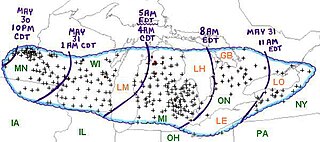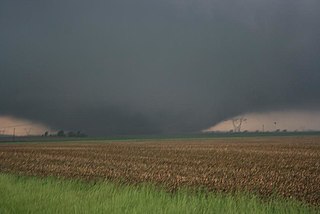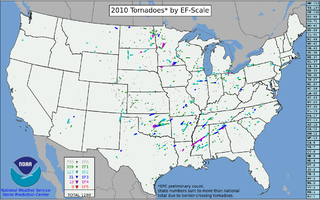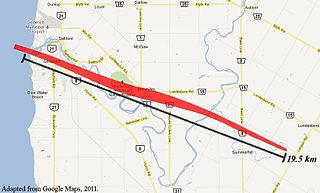
An extremely devastating and deadly tornado outbreak sequence impacted the Midwestern and Northeastern United States at the beginning of June 1953. It included two tornadoes that caused at least 90 deaths each—an F5 tornado occurring in Flint, Michigan, on June 8 and an F4 tornado in Worcester, Massachusetts, on June 9. These tornadoes are among the deadliest in United States history and were caused by the same storm system that moved eastward across the nation. The tornadoes are also related together in the public mind because, for a brief period following the Worcester tornado, it was debated in the U.S. Congress whether recent atomic bomb testing in the upper atmosphere had caused the tornadoes. Congressman James E. Van Zandt (R-Penn.) was among several members of Congress who expressed their belief that the June 4th bomb testing created the tornadoes, which occurred far outside the traditional tornado alley. They demanded a response from the government. Meteorologists quickly dispelled such an assertion, and Congressman Van Zandt later retracted his statement.

The 1985 United States–Canada tornado outbreak, referred to as the Barrie tornado outbreak in Canada, was a major tornado outbreak that occurred in Ohio, Pennsylvania, New York, and Ontario, on May 31, 1985. In all 44 tornadoes were counted including 14 in Ontario, Canada. It is the largest and most intense tornado outbreak ever to hit this region, and the worst tornado outbreak in Pennsylvania history in terms of deaths and destruction.

The Late-May 1998 tornado outbreak and derecho was a historic tornado outbreak and derecho that began on the afternoon of May 30 and extended throughout May 31, 1998, across a large portion of the northern half of the United States and southern Ontario from southeastern Montana east and southeastward to the Atlantic Ocean. The initial tornado outbreak, including the devastating Spencer tornado, hit southeast South Dakota on the evening of May 30. The Spencer tornado was the most destructive and the second-deadliest tornado in South Dakota history. A total of 13 people were killed; 7 by tornadoes and 6 by the derecho. Over two million people lost electrical power, some for up to 10 days.

This page documents notable tornadoes and tornado outbreaks worldwide in 2006. Strong and destructive tornadoes form most frequently in the United States, Bangladesh, and Eastern India, but they can occur almost anywhere under the right conditions. Tornadoes also develop occasionally in southern Canada during the Northern Hemisphere's summer and somewhat regularly at other times of the year across Europe, Asia, Argentina, Brazil and Australia. Tornadic events are often accompanied with other forms of severe weather, including strong thunderstorms, strong winds, and hail.
The heat wave of 2006 derecho series were a set of derechos — severe winds with powerful thunderstorms — that occurred on July 17–21, 2006. The first storms hit a wide swath of north-central and northeastern North America that stretched from the Upper Midwest through much of Ontario and into the northeastern United States. Another round struck the middle Mississippi River Valley, including two derechos that hit St. Louis, Missouri. The storms left more than three million people without power, some more than once and some for weeks.

This page documents the tornadoes and tornado outbreaks that occurred in 2007, primarily in the United States. Most tornadoes form in the U.S., although some events may take place internationally, particularly in parts of neighboring southern Canada during the summer season. Some tornadoes also take place in Europe, e. g. in the United Kingdom or in Germany.
The Early Winter 2006 North American storm complex was a severe winter storm that occurred on November 26, 2006, and continued into December 1. It affected much of North America in some form, producing various kinds of severe weather including a major ice storm, blizzard conditions, high winds, extreme cold, a serial derecho and some tornadoes.

On March 28, 1920, a large outbreak of at least 37 tornadoes, 31 of which were significant, took place across the Midwestern and Southern United States. The tornadoes left at least 153 dead and at least 1,215 injured. Many communities and farmers alike were caught off-guard as the storms moved to the northeast at speeds that reached over 60 mph (97 km/h). Most of the fatalities occurred in Georgia (37), Ohio (28), and Indiana (21), while the other states had lesser totals. Little is known about many of the specific tornadoes that occurred, and the list below is only partial.
On the evening of Tuesday, August 7, 1979, at least three tornadoes touched down in southwestern Ontario, devastating scores of farms and homes in the Woodstock area. The southern end of that city suffered some of the most intense destruction along with several other nearby towns in Oxford County. Two people died, 142 were injured, and hundreds of homes suffered significant damage. Overall monetary losses totaled an approximate $100 million in 1979 Canadian dollars.

The Southern Ontario tornado outbreak of 2005 was a series of thunderstorms on the afternoon of August 19, 2005, that spawned tornadoes damaging homes in the Conestoga Lake, Fergus, and Tavistock areas. A tornado was reported within the Toronto city limits, although this was never officially confirmed by the Meteorological Service of Canada. The storms morphed into heavy rain cells when reaching Toronto. The Insurance Bureau of Canada has estimated that insured losses were the highest in the province's history, exceeding 500 million Canadian dollars, two and a half times that of Ontario's losses during the 1998 ice storm and the second largest loss event in Canadian history until another event of torrential rain of July 8, 2013.

On Friday, May 31, 1985, a short-lived, but devastating, violent F4 tornado affected the City of Barrie, Ontario, Canada. The tornado was part of a larger outbreak that spanned both the preceding and the following day. The outbreak spawned several long-lived, cyclic, tornado-producing supercells over portions of Eastern Canada and the Great Lakes region of the Midwestern and Northeastern United States, one of which eventually generated the Barrie tornado.

The tornado outbreak sequence of June 3–11, 2008 was a series of tornado outbreaks affecting most of central and eastern North America from June 3–11, 2008. 192 tornadoes were confirmed, along with widespread straight–line wind wind damage. Seven people were killed from a direct result of tornadoes; four in Iowa, two in Kansas, and one in Indiana. Eleven additional people were killed across five states by other weather events including lightning, flash flooding, and straight-line winds. Severe flooding was also reported in much of Indiana, Wisconsin, Minnesota and Iowa as a result of the same thunderstorms, while high heat and humidity affected much of eastern North America; particularly along the eastern seaboard of the United States from New York City to the Carolinas.

From May 3 to May 11, 2003, a prolonged and destructive series of tornado outbreaks affected much of the Great Plains and Eastern United States. Most of the severe activity was concentrated between May 4 and May 10, which saw more tornadoes than any other week-long span in recorded history; 335 tornadoes occurred during this period, concentrated in the Ozarks and central Mississippi River Valley. Additional tornadoes were produced by the same storm systems from May 3 to May 11, producing 363 tornadoes overall, of which 62 were significant. Six of the tornadoes were rated F4, and of these four occurred on May 4, the most prolific day of the tornado outbreak sequence; these were the outbreak's strongest tornadoes. Damage caused by the severe weather and associated flooding amounted to US$4.1 billion, making it the costliest U.S. tornado outbreak of the 2000s. A total of 50 deaths and 713 injuries were caused by the severe weather, with a majority caused by tornadoes; the deadliest tornado was an F4 that struck Madison and Henderson counties in Tennessee, killing 11.

This page documents the tornadoes and tornado outbreaks of 2010. The majority of tornadoes form in the U.S., but they can occur almost anywhere under the right conditions. A lesser number occur outside the U.S., most notably in parts of neighboring southern Canada during the Northern Hemisphere's summer season, but are also known in South America, Europe, Asia, and Australia.

The following is a list of 2009 Minnesota tornadoes. Minnesota is a state located in the North Central United States along the northern edge of Tornado Alley, and on average receives 24 tornadoes per year. 2009 was an average year historically, with 24 confirmed tornado touchdowns. Twenty-two of the tornadoes (91%) were considered minor, rated EF0 or EF1 on the Enhanced Fujita scale. The remaining two tornadoes were rated as significant, at EF2.

From May 10–13, 2010, a major tornado outbreak affected large areas of Oklahoma, Kansas, Missouri, and Arkansas, with the bulk of the activity in central and eastern Oklahoma. Over 60 tornadoes, some large and multiple-vortex in nature, affected large parts of Oklahoma and adjacent parts of southern Kansas and Missouri, with the most destructive tornadoes causing severe damage in southern suburbs of the Oklahoma City metropolitan area and just east of Norman, Oklahoma, where the fatalities were reported from both tornado tracks. The outbreak was responsible for three fatalities, all of which occurred in Oklahoma. Damage was estimated to be over $595 million in central Oklahoma alone.

The June 2010 Northern Plains tornado outbreak was one of the most prolific summer tornado outbreaks in the Northern Great Plains of the United States on record. The outbreak began on June 16, with several tornadoes in South Dakota and Montana. The most intense storms took place the following day across much of eastern North Dakota and much of Minnesota. The system produced 93 tornadoes reported across four states while killing three people in Minnesota. Four of the tornadoes were rated as EF4 on the Enhanced Fujita scale, the most violent tornadoes in a 24-hour period since there were five within 15 hours in the 2008 Super Tuesday tornado outbreak. This was the region's first major tornado outbreak of the year and one of the largest on record in the region, comparable to a similar outbreak in June 1992. The 48 tornadoes that touched down in Minnesota on June 17 marked the most active single day in the state's history. June 17 was the second largest tornado day on record in the meteorological summer, behind the most prolific day of the 2003 South Dakota tornado outbreak on June 24, 2003.

The 2011 Goderich, Ontario tornado was an F3 tornado generated by an isolated supercell which unexpectedly tore across Huron County, Ontario, Canada on the afternoon of Sunday, August 21, 2011. Beginning as a tornadic waterspout over Lake Huron, the tornado ripped through the lakeside town of Goderich severely damaging the historic downtown and homes in the surrounding area. One person died and 37 more were injured as a result. This was the strongest tornado to hit Ontario in over fifteen years, since the April 20, 1996, tornado outbreak in Williamsford, Arthur, and Violet Hill.

The 2015–16 North American winter was not as frigid across North America and the United States as compared to the 2013–14 and 2014–15 winters. This was mainly due to a strong El Niño, which caused generally warmer-than-average conditions. However, despite the warmth, significant weather systems still occurred, including a snowstorm and flash flooding in Texas at the end of December and a large tornado outbreak at the end of February. The main event of the winter season, by far and large, was when a crippling and historic blizzard struck the Northeastern United States in late January, dumping up to 3 feet of snow in and around the metropolitan areas. Several other smaller snow events affected the Northeast as well, but for the most part the heaviest snowstorms and ice stayed out further west, such as a severe blizzard in western Texas in late December, and a major late-season snowstorm in Colorado in mid-April.















